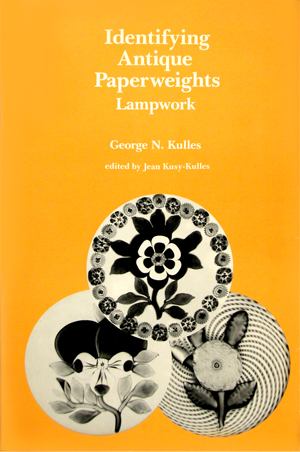Identifying Glass Paperweights—Lampwork
by: George N. Kulles
1987, Paperweight Press, Santa Cruz, CA
86 pages, $25. soft cover
flyleaf: “In Identifying Antique Paperweights—Lampwork, expert George Kulles tackles the challenge of analyzing and categorizing the vast array of lampwork designs and motifs featured in antique glass paperweights. Written as a companion volume to his first book, Identifying Antique Paperweights—Millefiori, this work provides collectors with the first concise, easy-to-use reference concentrating specifically on lampwork identification.
Antique glass paperweights, which have become extremely valuable and collectible in recent years, were first made during the 1840s in France. It is believed that the famous glass factories of that period, Baccarat, Clichy and Saint Louis, created these objects as means of showing off their expertise and enticing prospective customers. Whatever the reason for their making, glass paperweights proved very popular and quickly became desirable to collectors.
One of the intriguing aspects of paperweight collecting is the challenge of distinguishing one maker’s work from that of another.
In the nineteenth and early twentieth centuries several different makers often produced paperweights with the same flower or design. This book offers collectors the clues and information necessary to recognize the many subtleties and distinguishing variations between factories.
In the first part of this book, the most commonly found lampwork flowers, fruit and animals are listed, and examples by different makers are described in detail. Within these entries Kulles weaves a wealth of technical and historical information about paperweight making and makers. Line drawings on every page and color photographs clearly illustrate determining characteristics.
In addition to examining lampwork motifs, this book also provides information about how specific aspects of paperweight design can provide identification clues. Kulles describes and compares design features such as color grounds, air rings, torsades, garlands, swirls and spokes. He also presents valuable information about paperweight densities that can be helpful in determining the origin of a particular piece.
Although there will probably never be a simple foolproof method of identifying paperweights, Kulles’ detailed and well-researched book contributes greatly to the field. In addition to helping standardize the nomenclature and classification of lampwork motifs, he has created an excellent source book and guide for both beginning and experienced collectors.”

